-
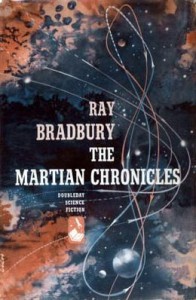 Today I want to comment on a story from Ray Bradbury’s The Martian Chronicles. This novel was assembled largely from previously published short stories, and “The Martian” is no exception. It was published in Super Science Stories in November, 1949, a year before the serial novel in which it was included would be released in the U.S.SPOILER WARNING! If you haven’t read this story and want to, seek it out now. It’s a short piece, and my discussion necessitates that I reveal the ending.This tale of a Martian shapeshifter has always had a certain resonance for me. Particularly as I’m coming to realize that, despite my often very-active social life, I’m really very much an introvert, this story of a creature profoundly influenced and affected by the emotions of those around it strikes a responsive chord. Introverts, I’ve learned, are not less in tune with the people around them than others. They’re usually more in tune. They have stronger empathy, are more easily able to see themselves in someone else’s shoes. Therein lies the rub. Introverts are more affected by the emotions of those around them, so they expend more energy on social interaction. In short, as I believe I’ve seen on a T-Shirt describing what it is to be an introvert, “I don’t hate people. I just find them exhausting!”But “The Martian” is more than an apt description of what it is to be an introvert; I think it’s also a parable about individual identity, our interdependence upon each other, and the damage that can be done to us by other people forcing their expectations upon us. I don’t know much about Mr. Bradbury’s politics, nor do I presume to pigeonhole them based on a 63-year-old short story; but I see this story addressing some of the same questions Ayn Rand addressed in her works: “Who owns my life?” “Do I owe others my time, my talents or my labor?” “Should I live for others?”
Today I want to comment on a story from Ray Bradbury’s The Martian Chronicles. This novel was assembled largely from previously published short stories, and “The Martian” is no exception. It was published in Super Science Stories in November, 1949, a year before the serial novel in which it was included would be released in the U.S.SPOILER WARNING! If you haven’t read this story and want to, seek it out now. It’s a short piece, and my discussion necessitates that I reveal the ending.This tale of a Martian shapeshifter has always had a certain resonance for me. Particularly as I’m coming to realize that, despite my often very-active social life, I’m really very much an introvert, this story of a creature profoundly influenced and affected by the emotions of those around it strikes a responsive chord. Introverts, I’ve learned, are not less in tune with the people around them than others. They’re usually more in tune. They have stronger empathy, are more easily able to see themselves in someone else’s shoes. Therein lies the rub. Introverts are more affected by the emotions of those around them, so they expend more energy on social interaction. In short, as I believe I’ve seen on a T-Shirt describing what it is to be an introvert, “I don’t hate people. I just find them exhausting!”But “The Martian” is more than an apt description of what it is to be an introvert; I think it’s also a parable about individual identity, our interdependence upon each other, and the damage that can be done to us by other people forcing their expectations upon us. I don’t know much about Mr. Bradbury’s politics, nor do I presume to pigeonhole them based on a 63-year-old short story; but I see this story addressing some of the same questions Ayn Rand addressed in her works: “Who owns my life?” “Do I owe others my time, my talents or my labor?” “Should I live for others?”Ray Bradbury, of course, is less controversial than Ayn Rand. He offers us a short work which teases at these questions and explores some possible consequences of answers to them, whereas the author of Atlas Shrugged has given us several works which not only explore these topic explicitly, but offer her own very detailed answers to the questions above.
Lafe and Anna LaFarge are an elderly couple, by the standards of 1949, and no doubt in the eyes of an author then not yet 30. He is 55 and she is 60. They have come to Mars as colonists to retire. As Anna notes, “We came here to enjoy our old age in peace.” The LaFarges are happy together, but they have survived a loss: their young son, Tom, died many years ago of Pneumonia. Lafe still thinks of him and misses visiting his grave every Sunday on Earth, but Anna prefers to let the dead lie and try to move on. Anna is clearly someone who accepts life as it comes, doesn’t ask too many questions, and finds joy in the moment.
The st
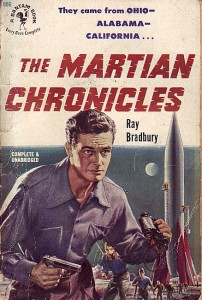 ory is set in the far-off year 2005 (2036, according to later re-issues of the book.) In 2012, it’s hard to imagine that we’re anywhere near building colonies on Mars and allowing private citizens to privately purchase spacecraft and homestead on our nearest neighboring planet. It’s rather sad to realize that, in 1949, it wasn’t hard to imagine. Many in the United States had more optimism then about the wonders technology would bring than we do now. They expected that the decades ahead would bring rapid change and an ever-accelerating race to the stars. It didn’t happen, and it looks as though it’s a long way off. Now though, we have some cause for optimism about the changes information technology will bring, perhaps helping to deliver freedom in place on this world where it’s never been enjoyed before. So perhaps what happened in a half-century is even more wonderful than what space enthusiasts hoped for back then.
ory is set in the far-off year 2005 (2036, according to later re-issues of the book.) In 2012, it’s hard to imagine that we’re anywhere near building colonies on Mars and allowing private citizens to privately purchase spacecraft and homestead on our nearest neighboring planet. It’s rather sad to realize that, in 1949, it wasn’t hard to imagine. Many in the United States had more optimism then about the wonders technology would bring than we do now. They expected that the decades ahead would bring rapid change and an ever-accelerating race to the stars. It didn’t happen, and it looks as though it’s a long way off. Now though, we have some cause for optimism about the changes information technology will bring, perhaps helping to deliver freedom in place on this world where it’s never been enjoyed before. So perhaps what happened in a half-century is even more wonderful than what space enthusiasts hoped for back then.Still, the LaFarges are pioneers of a sort, who apparently bought their own transportation: “In the distance, through the window, they saw rain gleaming on the sides of the rocket which had brought them from Earth.” I don’t imagine the rocket would be sitting in view of their house unless they owned it. Perhaps Bradbury only meant to imply that they could see the spaceport from their house, and the rocket was on the launch pad, as the Mayflower might have been docked where the Pilgrims could see it. But I prefer the idea of individually owned rockets, the metaphor of rockets as covered wagons.
In that same rain which casts a sheen on their rocket, Lafe, summoned from his bed by a strange, far-off whistling, sees the figure of a boy in the yard of their canal-side home. It’s dark. He can’t see well, but the figure looks like Tom. He tells Anna, who cries out to the spectral form to go away. She wants no part of it. She begs her husband to return to bed and lock the door. Instead, he calls to the figure that the door will be left open all night, and their visitor is welcome to warm himself by the hearth under fur rugs.
The next morning, Lafe is brought up short by the appearance in his living room of his 14-year-old son, happily carrying in bath water from the canal and commenting on what a glorious day it is. Lafe’s questions are diverted by the appearance of Anna, who accepts their once-again three-person family unit as if no death had ever occurred. Indeed, when Lafe questions her, she denies any knowledge of Tom’s illness or death.
Lafe deduces immediately that this person is a Martian, one of a race which was decimated not long ago by Earth-born pathogens accidentally spread by the first exploratory Earth exp
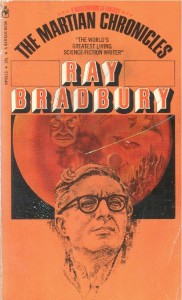 editions to Mars. He knows that surviving Martians are rare, and, when they appear, they often appear as humans. Lafe suggests to the boy that, if he were truly Tom, he would be far older than the fourteen years he claims. Tom’s reaction speaks to his motivation in coming to the LaFarges: he covers his face with his hands, as though trying to prevent it from changing (my inference) and says “Don’t doubt, please don’t doubt me!” He wants to be accepted. He doesn’t want the illusion to shatter. Pained by the questions his “father” is asking, Tom leaves the house at a run.
editions to Mars. He knows that surviving Martians are rare, and, when they appear, they often appear as humans. Lafe suggests to the boy that, if he were truly Tom, he would be far older than the fourteen years he claims. Tom’s reaction speaks to his motivation in coming to the LaFarges: he covers his face with his hands, as though trying to prevent it from changing (my inference) and says “Don’t doubt, please don’t doubt me!” He wants to be accepted. He doesn’t want the illusion to shatter. Pained by the questions his “father” is asking, Tom leaves the house at a run.When he returns, Tom speaks of almost being trapped and unable to ever return. He says he can’t explain what happened, doesn’t actually understand it, and won’t talk about it. Lafe promises him no questions will be asked. Lafe learns via neighborhood gossip what happened: Tom came near the tin shack of Nomland, a recluse. Nomland saw him not as a young boy, but as a man he, Nomland, had murdered on Earth. Nomland had fled to Mars to escape prosecution. Desperately frightened by the sudden resurrection of his victim, Nomland sought protection from local police, was refused, and finally committed suicide.
This encoun
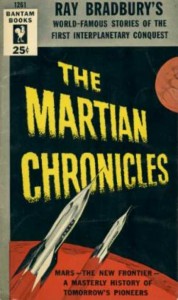 ter demonstrates that the Martian’s “ability” is not an ability at all. It’s simply a characteristic of his being. When he comes near, humans see him as whomever it is they have lost and have strong, unresolved emotional attachments to. It’s not just people they want to see, for it’s evident that Nomland didn’t want to see his victim. One assumes, however, that a victim is never far from a murderer’s thoughts, if he has anything resembling remorse in him. It’s also evident that Tom, the Martian, didn’t want to fulfill the role of resurrected victim. It was thrust on him by accident. Yet the reader knows he practically courted the LaFarges, for he approached them, and he admits he “sang” to them the night he appeared, in order to make it easier for them to accept him as their son. Tom’s behavior strongly suggests that he wanted to live among humans, that he picked the LaFarges deliberately, and that he wants to go on being their son.
ter demonstrates that the Martian’s “ability” is not an ability at all. It’s simply a characteristic of his being. When he comes near, humans see him as whomever it is they have lost and have strong, unresolved emotional attachments to. It’s not just people they want to see, for it’s evident that Nomland didn’t want to see his victim. One assumes, however, that a victim is never far from a murderer’s thoughts, if he has anything resembling remorse in him. It’s also evident that Tom, the Martian, didn’t want to fulfill the role of resurrected victim. It was thrust on him by accident. Yet the reader knows he practically courted the LaFarges, for he approached them, and he admits he “sang” to them the night he appeared, in order to make it easier for them to accept him as their son. Tom’s behavior strongly suggests that he wanted to live among humans, that he picked the LaFarges deliberately, and that he wants to go on being their son.When Anna proposes a family evening on the town, Tom makes it clear that he doesn’t want to be out in society. The LaFarges are enough for him. He’s afraid to be out among people. Lafe, knowing this is a Martian and already knowing that he can be seen by others as someone other than Tom, tries to shoot down the idea of an outing, but Anna is adamant. The result of the trip is as expected. Everyone who sees the Martian sees a lost loved one or a sought-after fugitive: a husband who deserted his wife, an escaped convict, the town mayor.
Lafe reflects on the motives of this strange creature: “Who is this… in need of love as much as we? Who is he and what is he that, out of loneliness, comes into the alien camp and assumes the voice and face of memory and stands among us, accepted and happy at last?” The happiness is not to last. Separated only briefly from the LaFarges, the Martian is spied by a couple whose daughter recently drowned in the canal. They bundle the “girl” off to their home. Lafe hears of this, and goes to retrieve Tom; but Tom is now Lavinia, and says he’s lost to the LaFarges. The feelings in this new house are too strong. When Lafe appeals to the Martian to remember that he was Tom, the poor creature makes perhaps the saddest statement I can imagine anyone making: “I’m not anyone. I’m just myself.”
Stop and consider identity. It’s who you are. It’s all you know. You can know a lot of people, become familiar with them, accept that they have the same basic emotions and needs that you do, and that you must accord them equal respect. You can devote your life to serving others and try to make the world a better place after you’ve left it, so strong can be your tie to your fellow humans. But all you know is you!
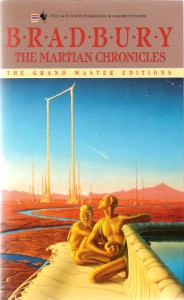 Your identity is the filter through which you experience everything. You can’t be certain, not absolutely certain, that anything you see, hear or feel is objective reality. You could be dreaming. You could be hallucinating. You could be on a table somewhere, drugged out of your mind. All you really know is that you are you. To say that that person, the only person you really know, is “no one,” is to relinquish all claim on sanity.
Your identity is the filter through which you experience everything. You can’t be certain, not absolutely certain, that anything you see, hear or feel is objective reality. You could be dreaming. You could be hallucinating. You could be on a table somewhere, drugged out of your mind. All you really know is that you are you. To say that that person, the only person you really know, is “no one,” is to relinquish all claim on sanity.But, whatever this poor creature’s previous history, that’s where he is when he encounters the LaFarges and the other humans. He seeks to adopt an identity from their memories. Whatever he – or it – was in the past is no longer important to him. At least, it’s not important enough for him to hold onto it if the cost of maintaining it is loneliness.
It’s an interesting question: what are we without others? “No man is an island,” we’re often told. We are social creatures. We need others to take care of us when we’re young, to help us when we’re in trouble, to be an audience for the work of performance art that is our life, to – if you’ll pardon the religious sentiment – share with us their own spark of the divine fire. Without others, our life couldn’t be what it is for us right now; and, I suppose, none of us can know what our loneliness might drive us to if all the others we’d ever known were suddenly gone.
But Bradbury’s story touches on the cost to the individual of trading in his identity to buy some relief from loneliness. The Martian whom we first met as Tom is finally destroyed, reduced to nothingness as he is overwhelmed by a crowd of humans, all of whom want him to be that person that they seek. “He was melting wax shaping to their minds,” says Bradbury, and then he is no more.
The demands of others, the roles they want us to play for their benefit, indeed can destroy us. Often, not understanding what they’re doing or not caring, they overtax us, taking, taking what it is they want, forgetting that we have our own identity, separate from the role they want us to play, and that it may not be able to survive if we abandon ourselves to the part.
Nor is it only in fulfilling the wants of others that we may lose ourselves. Nomland saw what he was afraid of, not what he directly wanted. (Unless, perhaps, he secretly wanted an end to guilt and an end to hiding from justice, and so saw the person who could drive him to end his misery.) There’s a need in many humans to have an enemy, a nemesis; to have someone at whom we can be good and pissed; to have someone to blame when things go wrong. Sometimes we force someone into that role, though they may have no idea who we are or why we’ve made them our enemy. We need someone to take the rap for all the evil in our lives.
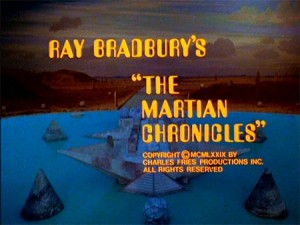 When he adapted this story for the 1980 television mini-series, The Martian Chronicles, Richard Matheson took the projection of human fears, desires and need for someone to blame up a level: he had the Martian appear to a Catholic priest as Jesus himself, the crucified Messiah. Atheist Ayn Rand would have (or might have been, as she was living when it aired) disgusted by the insertion of this religious image, and many Christians were offended. I must ask, however, what is Jesus but the ultimate scapegoat, the sacrificial lamb? What more appropriate symbol is there of the cost of taking on the sins, the needs and the problems of others? Of course, most believers consider Jesus divine, and so he is better equipped to carry such a burden than is a mere human, or Martian.
When he adapted this story for the 1980 television mini-series, The Martian Chronicles, Richard Matheson took the projection of human fears, desires and need for someone to blame up a level: he had the Martian appear to a Catholic priest as Jesus himself, the crucified Messiah. Atheist Ayn Rand would have (or might have been, as she was living when it aired) disgusted by the insertion of this religious image, and many Christians were offended. I must ask, however, what is Jesus but the ultimate scapegoat, the sacrificial lamb? What more appropriate symbol is there of the cost of taking on the sins, the needs and the problems of others? Of course, most believers consider Jesus divine, and so he is better equipped to carry such a burden than is a mere human, or Martian.The needs of the many outweigh the needs of the one, a certain green but non-Martian alien once told us. Imagine what happens when the needs of the many are dropped right on the head of the one. Bradbury explored this idea, and it didn’t make for a pretty picture. All those needs, all that weight, crushed the one. It bears consideration for us all, introvert or extrovert: what are you willing to trade – what are you trading – to enjoy the society of others?
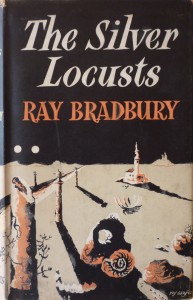 I re-read this story in a UK hardcover edition I happened to find in a now-defunct bookstore in Savage, MD. In England, the book was called The Silver Locusts. It includes a story, “The Fire Balloons,” which did not appear in the American edition, but omits “Usher II,” a particular favorite of mine.
I re-read this story in a UK hardcover edition I happened to find in a now-defunct bookstore in Savage, MD. In England, the book was called The Silver Locusts. It includes a story, “The Fire Balloons,” which did not appear in the American edition, but omits “Usher II,” a particular favorite of mine.
REVIEW – “The Martian” by Ray Bradbury
(Visited 234 times, 1 visits today)
